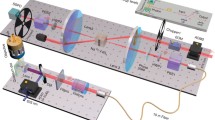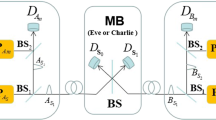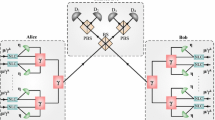Abstract
This paper proposes a quantum key distribution (QKD) scheme for measurement-device-independent QKD (MDI-QKD) utilizing quantum memory (QM), which is based on two distinct functions of QM: on-demand storage and multimode storage. We demonstrate a nonlinear increase in the secure key rate due to the utilization of QM. In the protocol incorporating on-demand storage, it is acknowledged that the secure key rate is scaled by \(R=O(\sqrt{\eta _{{\text {ch}}}})\) as \(\eta _{{\text {ch}}}\), while as an alternative approach, we reveal that the improvement is \(O(m_{\text {s}}^2)\), with \(m_{\text {s}}\) being the number of modes in frequency (spatial) multiplexing in the scheme incorporating multimode storage. We adopt an atomic frequency comb as a QM that incorporates the two functions and propose an architecture based on MDI-QKD to attain experimental feasibility. This scheme can be extended to quantum repeaters, and even for a single quantum-repeater node, there is a nonlinear enhancement and an experimental incentive to increase the number of modes.







Similar content being viewed by others
Data availability
The datasets generated during and/or analyzed during the current study are available from the corresponding author on reasonable request.
References
S. Wang, Z.-Q. Yin, D.-Y. He, W. Chen, R.-Q. Wang, P. Ye, Y. Zhou, G.-J. Fan-Yuan, F.-X. Wang, Y.-G. Zhu, Nat. Photonics 16(2), 154–161 (2022)
W. Zhang, T. Leent, K. Redeker, R. Garthoff, R. Schwonnek, F. Fertig, S. Eppelt, W. Rosenfeld, V. Scarani, C.C.-W. Lim, Nature 607(7920), 687–691 (2022)
D. Nadlinger, P. Drmota, B. Nichol, G. Araneda, D. Main, R. Srinivas, D. Lucas, C. Ballance, K. Ivanov, E.-Z. Tan, Nature 607(7920), 682–686 (2022)
W.-Z. Liu, Y.-Z. Zhang, Y.-Z. Zhen, M.-H. Li, Y. Liu, J. Fan, F. Xu, Q. Zhang, J.-W. Pan, Phys. Rev. Lett. 129(5), 050502 (2022)
H.-K. Lo, M. Curty, B. Qi, Phys. Rev. Lett. 108(13), 130503 (2012)
C. Jones, D. Kim, M.T. Rakher, P.G. Kwiat, T.D. Ladd, New J. Phys. 18(8), 083015 (2016)
P. Zeng, H. Zhou, W. Wu, X. Ma, Nat. Commun. 13(1), 1–11 (2022)
N. Sinclair, E. Saglamyurek, H. Mallahzadeh, J.A. Slater, M. George, R. Ricken, M.P. Hedges, D. Oblak, C. Simon, W. Sohler, Phys. Rev. Lett. 113(5), 053603 (2014)
X. Liu, J. Hu, Z.-F. Li, X. Li, P.-Y. Li, P.-J. Liang, Z.-Q. Zhou, C.-F. Li, G.-C. Guo, Nature 594(7861), 41–45 (2021)
D. Lago-Rivera, S. Grandi, J.V. Rakonjac, A. Seri, H. Riedmatten, Nature 594(7861), 37–40 (2021)
M. Pompili, S.L. Hermans, S. Baier, H.K. Beukers, P.C. Humphreys, R.N. Schouten, R.F. Vermeulen, M.J. Tiggelman, L. Santos Martins, B. Dirkse, Science 372(6539), 259–264 (2021)
G.-J. Fan-Yuan, F.-Y. Lu, S. Wang, Z.-Q. Yin, D.-Y. He, W. Chen, Z. Zhou, Z.-H. Wang, J. Teng, G.-C. Guo, Optica 9(7), 812–823 (2022)
S. Pirandola, R. Laurenza, C. Ottaviani, L. Banchi, Nat. Commun. 8(1), 1–15 (2017)
M. Lucamarini, Z.L. Yuan, J.F. Dynes, A.J. Shields, Nature 557(7705), 400–403 (2018)
X.-B. Wang, Z.-W. Yu, X.-L. Hu, Phys. Rev. A 98(6), 062323 (2018)
X. Ma, P. Zeng, H. Zhou, Phys. Rev. X 8(3), 031043 (2018)
P. Zeng, W. Wu, X. Ma, Phys. Rev. Appl. 13(6), 064013 (2020)
Y.-M. Xie, Y.-S. Lu, C.-X. Weng, X.-Y. Cao, Z.-Y. Jia, Y. Bao, Y. Wang, Y. Fu, H.-L. Yin, Z.-B. Chen, PRX Quantum 3(2), 020315 (2022)
C. Panayi, M. Razavi, X. Ma, N. Lütkenhaus, New J. Phys. 16(4), 043005 (2014)
S. Abruzzo, H. Kampermann, D. Bruß, Phys. Rev. A 89(1), 012301 (2014)
N.L. Piparo, N. Sinclair, M. Razavi, Quantum Sci. Technol. 3(1), 014009 (2017)
F. Rozpędek, K. Goodenough, J. Ribeiro, N. Kalb, V.C. Vivoli, A. Reiserer, R. Hanson, S. Wehner, D. Elkouss, Quantum Sci. Technol. 3(3), 034002 (2018)
F. Schmidt, P. Loock, Phys. Rev. A 102(4), 042614 (2020)
H.-J. Briegel, W. Dür, J.I. Cirac, P. Zoller, Phys. Rev. Lett. 81(26), 5932 (1998)
H. Buhrman, H. Röhrig, In: International Symposium on Mathematical Foundations of Computer Science, pp. 1–20. Springer (2003)
P. Komar, E.M. Kessler, M. Bishof, L. Jiang, A.S. Sørensen, J. Ye, M.D. Lukin, Nat. Phys. 10(8), 582–587 (2014)
S. Wehner, D. Elkouss, R. Hanson, Science 362(6412), 9288 (2018)
A. Dahlberg, M. Skrzypczyk, T. Coopmans, L. Wubben, F. Rozpędek, M. Pompili, A. Stolk, P. Pawełczak, R. Knegjens, J. Oliveira Filho, et al. In: Proceedings of the ACM Special Interest Group on Data Communication, pp. 159–173 (2019)
L.-M. Duan, M.D. Lukin, J.I. Cirac, P. Zoller, Nature 414(6862), 413–418 (2001)
R. Stockill, M. Stanley, L. Huthmacher, E. Clarke, M. Hugues, A. Miller, C. Matthiesen, C. Le Gall, M. Atatüre, Phys. Rev. Lett. 119(1), 010503 (2017)
L. Stephenson, D. Nadlinger, B. Nichol, S. An, P. Drmota, T. Ballance, K. Thirumalai, J. Goodwin, D. Lucas, C. Ballance, Phys. Rev. Lett. 124(11), 110501 (2020)
O. Collins, S. Jenkins, A. Kuzmich, T. Kennedy, Phys. Rev. Lett. 98(6), 060502 (2007)
S. Guha, H. Krovi, C.A. Fuchs, Z. Dutton, J.A. Slater, C. Simon, W. Tittel, Phys. Rev. A 92(2), 022357 (2015)
H. Krovi, S. Guha, Z. Dutton, J.A. Slater, C. Simon, W. Tittel, Appl. Phys. B 122(3), 1–8 (2016)
M. Afzelius, C. Simon, H. De Riedmatten, N. Gisin, Phys. Rev. A 79(5), 052329 (2009)
D. Luong, L. Jiang, J. Kim, N. Lütkenhaus, Appl. Phys. B 122(4), 1–10 (2016)
E. Saglamyurek, N. Sinclair, J.A. Slater, K. Heshami, D. Oblak, W. Tittel, New J. Phys. 16(6), 065019 (2014)
M.K. Bhaskar, R. Riedinger, B. Machielse, D.S. Levonian, C.T. Nguyen, E.N. Knall, H. Park, D. Englund, M. Lončar, D.D. Sukachev, Nature 580(7801), 60–64 (2020)
N. Sinclair, K. Heshami, C. Deshmukh, D. Oblak, C. Simon, W. Tittel, Nat. Commun. 7(1), 1–6 (2016)
K. Niizeki, D. Yoshida, K. Ito, I. Nakamura, N. Takei, K. Okamura, M.-Y. Zheng, X.-P. Xie, T. Horikiri, Commun. Phys. 3(1), 1–7 (2020)
J. Pseiner, L. Achatz, L. Bulla, M. Bohmann, R. Ursin, Quantum Sci. Technol. 6(3), 035013 (2021)
M. Müller, S. Bounouar, K.D. Jöns, M. Glässl, P. Michler, Nat. Photonics 8(3), 224–228 (2014)
M. Razavi, M. Piani, N. Lütkenhaus, Phys. Rev. A 80(3), 032301 (2009)
P. Jobez, N. Timoney, C. Laplane, J. Etesse, A. Ferrier, P. Goldner, N. Gisin, M. Afzelius, Phys. Rev. A 93(3), 032327 (2016)
A. Ortu, J.V. Rakonjac, A. Holzäpfel, A. Seri, S. Grandi, M. Mazzera, H. Riedmatten, M. Afzelius, Quantum Sci. Technol. 7(3), 035024 (2022)
O. Pietx-Casas, G.C.D. Amaral, T. Chakraborty, R. Berrevoets, T. Middelburg, J.A. Slater, W. Tittel, (2021) arXiv preprint arXiv:2111.13610
R. Valivarthi, I. Lucio-Martinez, A. Rubenok, P. Chan, F. Marsili, V.B. Verma, M.D. Shaw, J. Stern, J.A. Slater, D. Oblak, Opt. Express 22(20), 24497–24506 (2014)
W.P. Grice, Phys. Rev. A 84(4), 042331 (2011)
T. Mizuno, T. Kobayashi, H. Takara, A. Sano, H. Kawakami, T. Nakagawa, Y. Miyamoto, Y. Abe, T. Goh, M. Oguma, et al. In: Optical Fiber Communication Conference, pp. 5–2. Optica Publishing Group (2014)
M. Gündoğan, P.M. Ledingham, A. Almasi, M. Cristiani, H. De Riedmatten, Phys. Rev. Lett. 108(19), 190504 (2012)
X. Ma, M. Razavi, Phys. Rev. A 86(6), 062319 (2012)
Acknowledgements
We thank Mohsen Razavi, Nicolò Lo Piparo, Masoome Fazelian, Kae Nemoto, and Toshihiko Sasaki for valuable discussions. This research was supported by JST Moonshot R &D Grant Number JPMJMS226C, JSPS KAKENHI Grant Number JP20H02652, and the National Institute of Information and Communications Technology Young Researchers Lab. We also acknowledge the members of the Quantum Internet Task Force, which is a research consortium aiming to realize the quantum internet, for comprehensive and interdisciplinary discussions of the quantum internet.
Author information
Authors and Affiliations
Corresponding author
Additional information
Publisher's Note
Springer Nature remains neutral with regard to jurisdictional claims in published maps and institutional affiliations.
Appendices
Appendix A: Calculation of key rates dependent on \(T_2\)
If QM with on-demand storage is utilized, \(Y_{11}^{{\text {QM}}}\) can be described as follows [19, 36]:
where \(\eta _{1K}, \eta _{\mu (\nu ) K}\quad (K=A,B)\) represent the readout efficiency from QM in single-photon states and average photon number \(\mu (\nu )\), respectively. Moreover, \(Y_{11}\) is given as follows [51]:
where \(N_{\text {L}}\) represents the average number of attempts to load both QMs. The average number of attempts to load both memories, i.e., \(N_{\text {L}}(\eta _A,\eta _B)\), is approximated by \(N_{\text {L}} = \frac{3-2\eta _A}{\eta _A(2-\eta _A)} \approx \frac{3}{2\eta _A}\) when \(\eta _A = \eta _B \ll 1\) in the no-multimode scenario [32]. Furthermore, \(\eta _{{\text {early}}}\) and \(\eta _{{\text {late}}}\) represent the loading efficiencies of the QMs for photons arriving early and late, respectively [19]:
where t represents the storage time of the QM in the event that it is loaded early, which is given as \((t=|N_A-N_B|\tau )\). The calculation of the expected value for \(\eta _{{\text {early}}}\) is as follows:
Appendix B: Calculation of key rates dependent on temporal multiplexing \(m_{\text {t}}\)
The multimode AFC protocol (frequency multiplexing/spatial multiplexing scheme) in Sect. 3 was considered as temporal multiplexing \(m_{\text {t}}\) with \(m_{\text {t}}=1\), but it can be extended to the case of temporal multiplexing (\(m_{\text {t}}>1\)). A schematic of the QM when temporal multiplexing is incorporated is depicted in Fig. 8. It is necessary to store \(m_{\text {s}}m_{\text {t}}\) photons across \(m_{\text {t}}\) slots and match them accordingly.
Here, \(Y_{11}\) represents the success rate of the BSM, as described in Appendix 1. The success probability \(\eta _K^{{\text {mm}}}\) of the frequency-multiplexed and time-multiplexed S-BSM is given as follows:
Here, in contrast to frequency/spatial multiplexing, temporal multiplexing results in a linear increase in \(O(m_{\text {t}})\), as \(m_{\text {t}}\) appears in the denominator of the rate Eq. 6, reducing the number of middle BSM attempts per unit time.
As illustrated in Fig. 9, as \(m_{\text {t}}\) increases, the plateau region expands; however, the overall rate decreases linearly with an increase in the time required to execute BSM, which is \(m_{\text {t}}\tau \). Additionally, optimizing the number of temporal modes \(m_{\text {t}}\) with consideration of the distance results in rate scaling of \(O(\sqrt{\eta _{{\text {ch}}}})\), as observed in the envelope.
Rights and permissions
Springer Nature or its licensor (e.g. a society or other partner) holds exclusive rights to this article under a publishing agreement with the author(s) or other rightsholder(s); author self-archiving of the accepted manuscript version of this article is solely governed by the terms of such publishing agreement and applicable law.
About this article
Cite this article
Mizutani, Y., Horikiri, T. Nonlinear improvement of measurement-device-independent quantum key distribution using multimode quantum memory. Appl. Phys. B 129, 121 (2023). https://doi.org/10.1007/s00340-023-08063-2
Received:
Accepted:
Published:
DOI: https://doi.org/10.1007/s00340-023-08063-2






